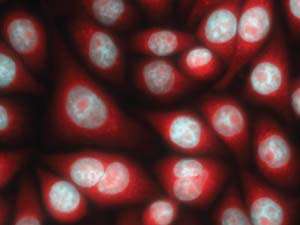Translating the ribosome's grim role

A large number of long noncoding RNAs (lncRNA) have been found associating with the ribosome, the protein-making machinery in the cytoplasm. What the so-called 'noncoding' RNAs are doing on the ribosome, whose main job is to translate RNA into protein, has puzzled the A*STAR researchers who discovered them.
The answer could be macabre, suggest cell biologist, Leah Vardy, at the A*STAR Institute of Medical Biology and bioinformatician, Rory Johnson, at the University of Bern, Switzerland. Translation by the ribosome could lead to the degradation of these lncRNAs, says Vardy. "The ribosome may be acting as a garbage dump or graveyard for lncRNAs at the end of their life."
In recent years, researchers have found that many RNAs previously labeled as junk, actually play an important role in causing a wide range of diseases, from cancers to metabolic disease and neurodegeneration. Still, many questions remain about their basic biology, with studies covering less than one per cent of the tens of thousands of lncRNAs in our genomes. "LncRNAs are one of the most promising avenues for understanding disease today," says Johnson.
One question that confounded Vardy and Johnson was why lncRNAs were in the cytoplasm when they were thought to be confined to the nucleus. By applying a technique for studying messenger RNA translation, they discovered that most of the lncRNAs in the cytoplasm were bound to ribosomes. "This was surprising because, by definition, lncRNAs were not thought to be translated," says Johnson.
To make sense of their results, the researchers tinkered with the translation process to see how it would affect the lncRNAs. The lncRNAs decayed very quickly in normal cells, but when the researchers used a drug to block translation, they decayed at a much slower rate. "Some ribosome-bound lncRNAs become more stable when translation is inhibited," explains Vardy.
The findings suggest that ribosomes are where some lncRNAs may go to die, a process similar to the well-known mechanism of 'nonsense mediated decay', in which ribosomes promote the degradation of malformed messenger RNAs. The researchers found that ribosome-bound lncRNAs look more "mRNA like" than their free-floating counterparts in the cytoplasm. "In some ways, lncRNAs look like malformed mRNAs, and for this reason may enter the nonsense mediated decay pathway," explains Johnson.
To confirm their hypotheses about the fatal affair between noncoding RNAs and protein-coding ribosomes, Vardy and Johnson plan to study the relationship at an individual level to understand how they are regulated and whether they perform both coding and non-coding functions.
The A*STAR-affiliated researchers contributing to this research are from the Institute of Medical Biology. For more information about the team's research, please visit the Epidermal Gene Regulation webpage.
More information: Joana Carlevaro-Fita et al. Cytoplasmic long noncoding RNAs are frequently bound to and degraded at ribosomes in human cells, RNA (2016). DOI: 10.1261/rna.053561.115

















